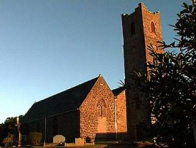 |
 |
Parishes
Magheraculmoney
|
The Revd Mark Loney |
|
|
![]() Click here to visit the Magheraculmoney (Ardess) Parishes Facebook page
Click here to visit the Magheraculmoney (Ardess) Parishes Facebook page
|
|
Service Times
11.00am Morning Service in St. Mary's Parish Church, Ardess (each Sunday)
Magheraculmoney Parish Church - A Brief History
St. Mary's Church
Dominating the drumlin landscape of the quiet rural townland community of Ardess is the historic St. Mary's Church of Magheraculmoney Parish. Records state that the Church (also previously known as Templemaghery Church) was originally built during the fourteenth century and was burnt in 1484. Part of today's present stone built structure can be dated as far back as fifty years before the Reformation. In 1622 the church is described as "lately roofed but not glazed". It had no house but did have four tates of land in the possession of the rector with a fifth destined for Mr. Blennerhassett, the local patron. Its value in 1634 is given at £100.
Having since undergone extensive alterations and enlargements during the eighteenth, nineteenth and twentieth centuries, Ardess Church with its three stage tower now stands proudly as a distinctive landmark in Ardess. Directly beneath the Church at Ardess also lies the family vault of the Archdales once one of Fermanagh's premier families since the plantation.
Famine Pit
Running right across and dividing the pre-plantation cemetery in two is a huge fourteen foot wide trench grave. Described locally as the Famine Pit the huge long narrow sunken grave of 120 feet had remained in an overgrown, unkempt state serving as a harsh visual reminder of the Great Famine period 1845 - 1850. In 1997 the newly formed Ardess Community Association's immediate objective was to mark the 150th anniversary of 1847 (known as Black 47) by firstly restoring the unmarked famine pit and subsequently creating a sensitive memorial commemorating the many forgotten famine victims from North West Fermanagh.
Drawing on the experiences of fitting memorials that were being erected by community history groups in Enniskillen, Lisnaskea, Belcoo and Irvinestown, the Association commissioned well known model make and artist Gordon Johnston from Enniskillen to gain an understanding of the circumstances surrounding the creation and location of the Famine Pit. The resulting design comprises of four integral parts that reflect both the historical and spiritual atmosphere of Ardess and serves as a poignant reminder of the significant site.
The Famine Pit serviced the human tragedy that unfolded in the Lowtherstown (Irvinestown) Workhouse and it is estimated that the bodies of some two hundred victims of the famine period from throughout the Irvinestown Poor Law Union area were buried anonymously. Over time the trench emerged, after having been filled as a mound, when the large number of bodies it contained, decomposed. In death, as perhaps in life, the famine victims had nothing but the transient space their bodies occupied in an unmarked sunken trench grave. Using traditional stonemasonry methods and local grey limestone the tumbledown sides of the Famine Pit have been strengthened and preserved with the stonewalling tastefully blending in with the vaulted tomb marking the end of the Famine Pit.
Graveyard
The distinctive graveyard surrounding ST. Mary's Church at Ardess is immediately recognisable as an ancient pre-plantation graveyard and in a survey it is estimated that there is a total of 433 marked grave headstones, flat slabs and crosses. The oldest visible date is 1679 and the most recent is 1984. From 1608 until 1903 the graveyard served both Protestant and Catholic families in the district. All these graves face east with the exception of priests' who, according to local folklore, face west reportedly overlooking their flock.

